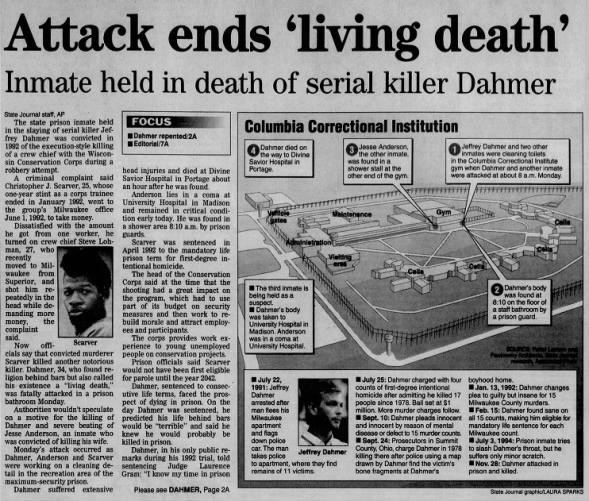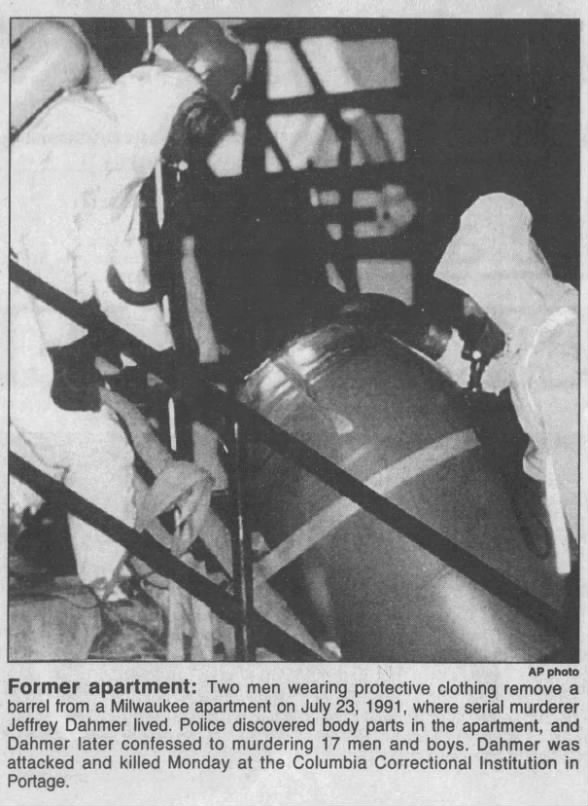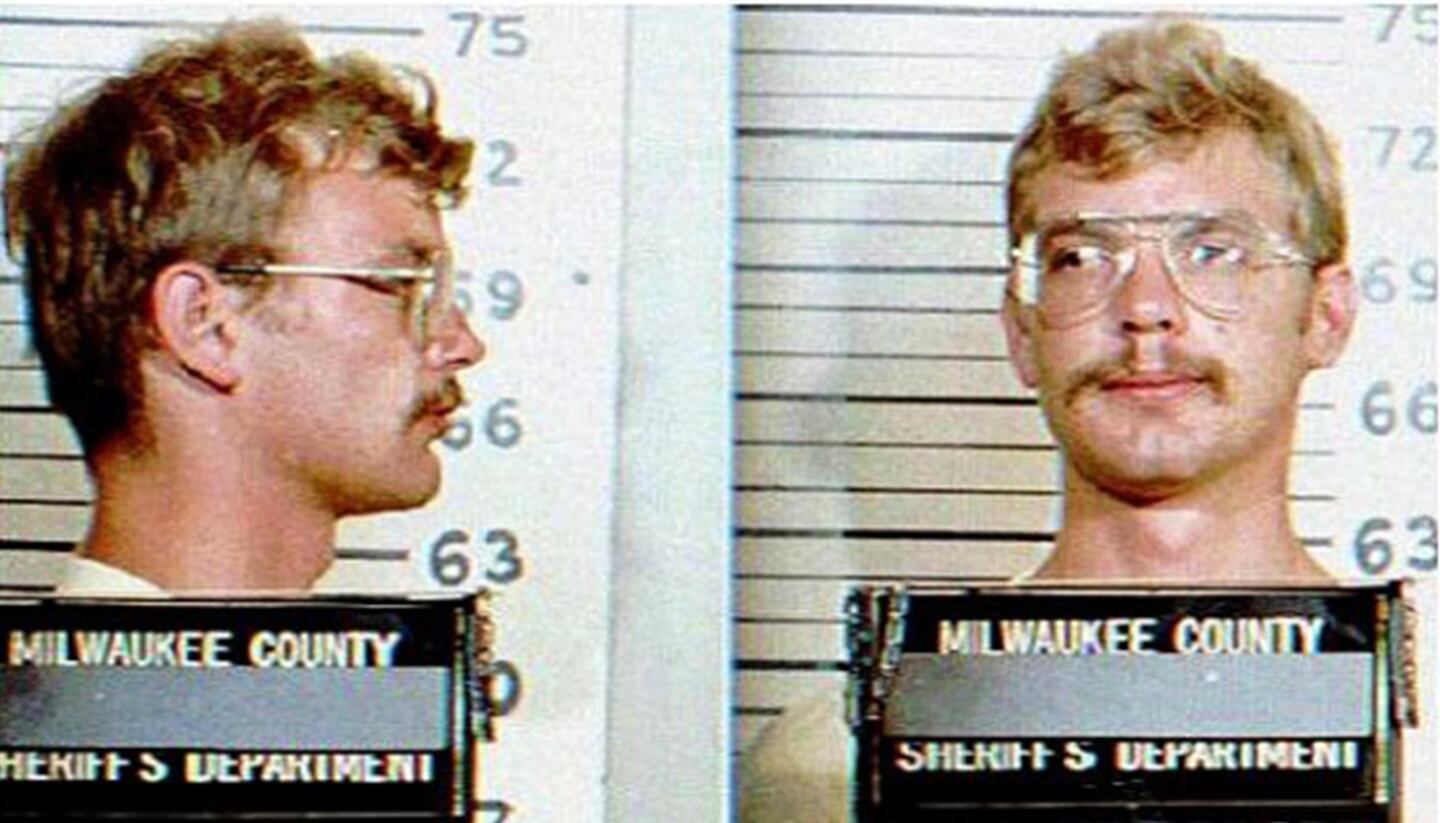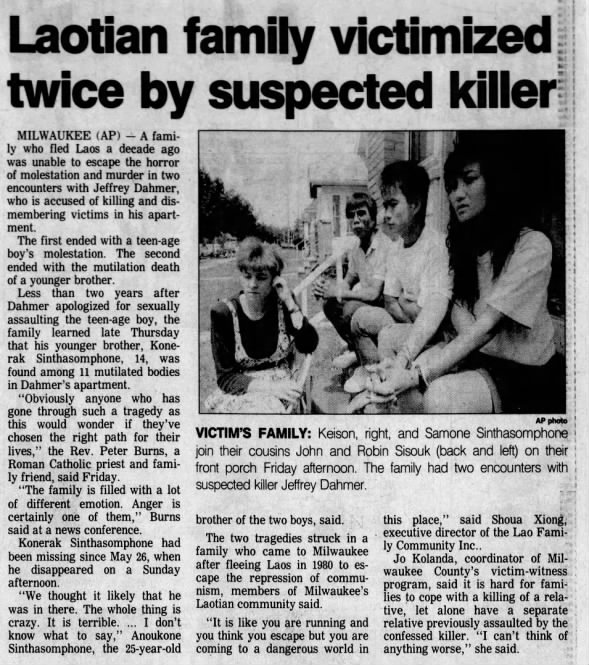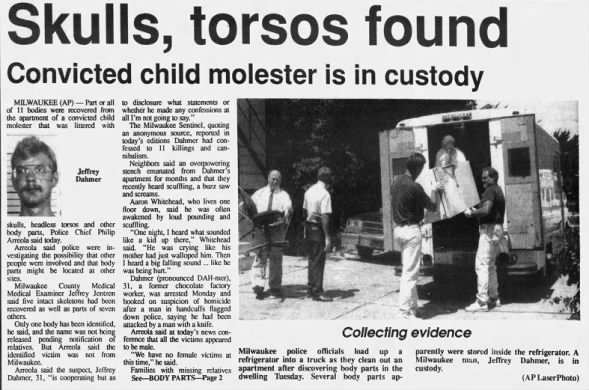MILWAUKEE — The stench of death emanating from unit 213 at the Oxford Apartments had been noticeable for months before police came calling.
Residents soon learned the grisly source of the odor, and the public watched in horror as crime scene technicians in protective gear wheeled a 57-gallon drum and a refrigerator full of body parts out of the building.
Within days, the whole world would know the name of the man who lived in that Milwaukee apartment: Jeffrey Dahmer.
Since his arrest in July 1991, Dahmer, then 31, has become one of the most notorious serial killers in U.S. history. The former chocolate factory worker confessed to killing and dismembering 17 young men and boys, including one at his boyhood Ohio home, between 1978 and 1991.
FBI records indicate that Dahmer told detectives he “did not mean to kill but wanted to create ‘love slaves’ or zombies that would do everything (he) pleased.”
Dahmer confessed to having sex with some of his victims’ bodies, as well as cannibalizing some body parts and preserving others. He was ultimately caught because his final victim, Tracy Edwards, managed to escape Dahmer’s apartment and run for help, a set of handcuffs dangling from one wrist.
After pleading guilty to 15 murders in Milwaukee, Dahmer’s sanity was put on trial. He was found to be sane and sentenced to 15 sentences of life in prison.
Dahmer was beaten to death by a fellow inmate in November 1994.
“DAHMER — Monster: The Jeffrey Dahmer Story,” which premiered Wednesday on Netflix, is the latest attempt to tell the story of Dahmer and the men he killed. According to Variety, the 10-episode limited series is told primarily from the perspective of the victims and their families.
“(The series) will also explore the incompetence of the Wisconsin police during the murder investigations, allowing Dahmer to continue his killing spree,” Variety reported.
Evan Peters of “American Horror Story” plays the role of Dahmer. The series is directed by Ryan Murphy.
The retelling is receiving mixed reviews, including criticism from family members of some of the victims. On social media, a cousin of victim Errol Lindsey wrote that he would not be watching the series, which he said has caused the family fresh pain.
“I’m not telling anyone what to watch. I know true crime media is huge right now, but if you’re actually curious about the victims, my family (the Isbells) are pissed about this show,” Twitter user ericthulhu wrote. “It’s retraumatizing over and over again, and for what? How many movies/shows/documentaries do we need?”
I’m not telling anyone what to watch, I know true crime media is huge rn, but if you’re actually curious about the victims, my family (the Isbell’s) are pissed about this show. It’s retraumatizing over and over again, and for what? How many movies/shows/documentaries do we need? https://t.co/CRQjXWAvjx
— eric. (@ericthulhu) September 22, 2022
Editor’s note: This story contains extremely graphic descriptions of violent crimes.
The savagery begins
Dahmer would later tell detectives he committed his first murder three weeks after his high school graduation in Bath Township, Ohio. His adolescence had not been a particularly happy one, and by the age of 14, the quiet, withdrawn boy had turned to beer and hard liquor to deal with his problems.
He had also begun dissecting dead animals he found around his neighborhood and, after realizing he was gay, having violent sexual fantasies involving other boys.
Billy Capshaw, who bunked with Dahmer during his stint in the U.S. Army, described a sober Dahmer as being “like a doctor you’d go to see who comforts you and smiles a lot.” That changed when he drank, Capshaw told The Associated Press in 1991.
“When I saw him that way for the first time, I ran from him,” Capshaw said. “I knew for a fact he was gonna hurt me if he ever got ahold of me.”
On June 18, 1978, an 18-year-old Dahmer picked up hitchhiker Steven Mark Hicks, 18, of Coventry, Ohio, and lured him to his family’s home with the promise of beer. Dahmer’s parents had split up by that point, and his father was out of town on business, leaving the teen with the house to himself.
Dahmer told Inside Edition in 1993 that he wasn’t planning to kill Hicks that night.
“I was coming back from the shopping mall back in ‘78,” Dahmer said. “I’d had fantasies about picking up a hitchhiker, taking him back to the house and having complete dominance and control over him.”
Watch one of the trailers for the Netflix series about Dahmer below.
Dahmer had hoped to have sex with Hicks that night, but after drinking for a while, Hicks wanted to leave. Dahmer bludgeoned him with a 10-pound dumbbell, then strangled him with the bar of the dumbbell.
He sexually abused Hicks’ body, and the following day, he dissected him in the basement and buried the body parts in the back yard. Several weeks later, he retrieved the remains and used acid to dissolve Hicks’ flesh from the bones.
He crushed the bones and scattered them behind his family’s house. The liquified flesh, he flushed down a toilet.
Dahmer almost didn’t get away with the crime.
“Dahmer advised that he should have been caught after the first murder … but the police were not thorough,” FBI reports state.
According to Dahmer, he had Hicks’ dismembered body in his car the night of the murder when he was pulled over by police for a minor traffic violation.
“Dahmer stated that two police officers then ordered him out of the car, and they shined their flashlights in his car and saw the garbage bag,” records state. “(They) asked Dahmer what was in the bag and what the terrible smell was.”
Dahmer told the officers he was bringing some old garbage to the city dump. They failed to look in the bag and let Dahmer leave after issuing a citation for the traffic violation.
Watch another trailer for the Netflix series below.
It would not be the last time police officers missed signs of trouble when encountering Dahmer.
Frightened by his narrow escape, Dahmer did not kill again for nearly a decade. Meanwhile, he joined the Army and was stationed in Germany.
The urge to kill never left him, he told Inside Edition.
“There just wasn’t an opportunity to fully express what I wanted to do,” Dahmer said. “There was just not the physical opportunity to do it then.”
After being discharged in 1981 due to his excessive drinking, Dahmer returned briefly to Ohio. He was arrested on a charge of drunk and disorderly conduct, and his father and stepmother sent him to live with his grandmother in the Milwaukee suburb of West Allis.
Dahmer was arrested a couple more times, once for exposing himself at Wisconsin State Fair Park and the other for masturbating in front of two boys. According to Biography.com, he was sentenced to probation and ordered to undergo counseling.
He began working nights as a mixer at the Ambrosia Chocolate Company in Milwaukee. He also began frequenting the city’s gay bars and gay bathhouses.
Dahmer’s craving for dominance led him to drug his sexual partners and have sex with them while they were unconscious.
In 1987, the killing began again in earnest.
Modus operandi and missed opportunities
Steven Walter Tuomi, 25, of Ontonagon, Michigan, was visiting Milwaukee when Dahmer met him at a bar on Nov. 20, 1987. The men went to a hotel room Dahmer had rented.
Dahmer later told police he had no intention of killing Tuomi that night. The following morning, however, he awoke to find Tuomi dead beside him, his chest crushed. Dahmer had no memory of committing the murder.
He placed Tuomi’s body in a suitcase and hailed a cab to his grandmother’s house. The cab driver helped load the heavy luggage into the car.
“Dahmer stated that the cabbie asked (him) what was in the suitcase, because it smelled so bad and was very heavy,” FBI documents state.
Dahmer didn’t answer. He took Tuomi’s body to his grandmother’s house, where he dismembered him and disposed of his body — minus his head — in the trash.
He kept the head for a couple of weeks, boiling it in bleach and industrial detergent. The process made the skull too brittle, however, and he pulverized it and disposed of it, Biography.com states.
None of Tuomi’s remains were ever found.
Most of Dahmer’s crimes played out in a similar fashion. On Jan. 16, 1988, Dahmer lured James Doxtator, a 14-year-old sex worker he met outside a gay bar, to his grandmother’s home with the promise of cash for nude photos. Dahmer strangled the teen and hid him in the basement.
After a week, he got rid of the body in the trash as he had Tuomi’s.
Two months later, on March 24, 1988, Dahmer did the same to 22-year-old Richard Guerrero.
That September, Dahmer’s grandmother grew tired of his odd habits and the terrible odors that would waft up from the basement where he spent so much of his time. She asked her grandson to move out.
Two days after moving into an apartment, Dahmer was arrested for drugging and fondling a 13-year-old Laotian boy, Keison Sinthasomphone, who he had lured to his new home. After the boy reported Dahmer to the police, investigators searched Dahmer’s home — and failed to spot a human skull in a drawer that was searched.
“Dahmer felt that they had tunnel vision, and they were looking for drugs and nude photographs and passed right over the skull, which he had covered with a towel,” FBI agents wrote.
He was released on bail and remained free even after pleading guilty to sexual assault and enticing a child for immoral purposes.
On March 25, 1989, while awaiting his sentencing, Dahmer met aspiring model Anthony Sears, 24, at a gay bar. Believing the police were watching his apartment, he took Sears to his grandmother’s house, where they had sex. Dahmer then drugged, strangled and dismembered him, according to reports.
Sears, who Dahmer later said he’d found “exceptionally attractive,” was the first victim from whom Dahmer kept souvenirs for more than a few weeks. He preserved Sears’ head and his genitals and stored them in a wooden box that police found after his 1991 arrest.
In May 1989, Dahmer was sentenced in his sexual assault case. Though he was required to register as a sex offender, he was ordered to serve only a year at a work release program and was placed on five years’ probation.
The killer was paroled after just 10 months. He temporarily moved back in with his grandmother but soon moved into the Oxford Apartments, where 12 more victims would die.
‘Very tender and juicy’
On May 20, 1990, Dahmer lured Raymond Lamont Smith, a 32-year-old sex worker, to his new apartment, where he drugged and strangled him. He boiled Smith’s body parts in acid to get rid of the remains but kept his skull, which he spray-painted gray, according to news and police reports.
The following month, an acquaintance of Dahmer’s, Edward Warren Smith, 27, became his next victim. In September, Dahmer killed Ernest Marquez Miller and David Courtney Thomas, both 22.
Dahmer killed Miller, who was a dance student, by slashing his carotid artery. He then dismembered the man, whose body he ultimately kept.
According to reports, Dahmer stashed Miller’s skeleton in a filing cabinet while placing his heart, biceps and pieces of his legs in the freezer to eat later.
In interviews with FBI agents, Dahmer admitted that he had eaten some of his victims’ hearts, along with livers and thigh meat. He once ate a bicep, as well.
“Dahmer stated that he would prepare this feast by frying the organ in a skillet on the stove, the way you would prepare a regular piece of meat,” the FBI reports state. “Dahmer stated that he cut the pieces into small sizes that were small enough to eat.
“Dahmer stated that he found the meat to be very tasty, and Dahmer described it as eating a filet mignon which was very tender and juicy.”
Dahmer, who described the cannibalism as “branching out,” told Inside Edition that eating his victims’ flesh made him feel like they were forever a part of him.
Watch Dahmer’s jailhouse interview below.
The killing stopped for a while, but on Feb. 18, 1991, Dahmer encountered Curtis Durrell Straughter, 17, at a bus stop. Like his other victims, Straughter was taken to Dahmer’s apartment, drugged, strangled and dismembered.
Dahmer’s life was starting to spiral further, the killings became more and more frequent, and Dahmer began keeping more and more of his victims’ bodies. He later told police he intended to build a private shrine adorned with the men’s skulls and skeletons.
He also began experimenting with a ghastly new procedure: drilling holes into victims’ skulls and injecting the cavity with hydrochloric acid or boiling water.
Dahmer later told detectives he wanted to make the men zombie-like and complacent.
His first victim to suffer that fate was Errol Lindsey, 19, who awoke after the April 7, 1991, procedure complaining of a headache, according to authorities. Dahmer again drugged him into unconsciousness and strangled him, keeping Lindsey’s skull and portions of his skin.
Tony Anthony Hughes, 31, met Dahmer May 24, 1991, at a bar. Hughes, who was deaf, communicated with his killer through handwritten notes.
After going to Dahmer’s apartment to pose for photos, Hughes was strangled. Dahmer kept his body on his bedroom floor for three days before dismembering him.
Dahmer’s next victim would prove to be his most controversial, not for his behavior but that of patrol officers. On May 27, 1991, Dahmer met Konerak Sinthasomphone, who he lured to his apartment and drugged as Hughes’ intact body lay on the floor in the other room.
In a bizarre twist, the 14-year-old Sinthasomphone was the younger brother of the teen whom Dahmer had sexually assaulted in 1988.
Like Lindsey, Sinthasomphone had holes drilled into his head and acid poured in. According to authorities, Dahmer left the sedated boy alone while he went to the store to buy beer.
When he returned, he found Sinthasomphone, dazed, naked and bleeding, talking to two young women at a nearby intersection. One of the women called police.
“I’m on 25th and State, and there is this young man,” the caller said, according to court records. “He’s buck naked. He has been beaten up. ... He is really hurt. ... He needs some help.”
When police and fire medics arrived, the women were trying to keep Dahmer from taking Sinthasomphone back to his apartment. The officers, who told the medics they could leave, shrugged off the women’s concerns, including their adamant belief that the boy was underage.
Dahmer told the officers that Sinthasomphone was his 19-year-old lover and that he’d left the apartment following an argument.
The officers believed Dahmer over the women, who were Black, and walked Sinthasomphone back to the apartment, where they said they saw nothing unusual.
According to Time magazine, Dahmer later told investigators that the officers failed to notice photos of his slain victims strewn around the apartment. They also failed to pick up on the presence of Hughes’ body, which Dahmer said was “smelling like hell.”
The officers also failed to check Dahmer’s identification or background. If they had, they would have learned he was a registered sex offender on parole for molesting Sinthasomphone’s brother.
The officers joked as they left the apartment, including making comments on the police radio.
“Intoxicated Asian, naked male,” one officer said. “Was returned to his sober boyfriend.”
The officer then said his partner was “going to get deloused” after being in the company of who they believed were two gay men.
Meanwhile, back in his apartment, Dahmer poured more acid into Sinthasomphone’s skull. It killed the boy, whose body was then dismembered.
His head was later found in Dahmer’s freezer.
The circumstances of Sinthasomphone’s murder, when discovered, incensed the public, particularly in the Black and gay communities. Glenda Cleveland, whose daughter and niece were the women who tried to help the boy, repeatedly called the police to find out what had been done about the “child,” Time reported.
“It wasn’t a child, it was an adult,” one of the officers from the scene told her, according to the news magazine. “It is all taken care of. It’s a boyfriend-boyfriend thing.”
Cleveland is portrayed by actress Niecy Nash in the Netflix limited series on the case.
Two of the officers, John Balcerzak and Joseph Gabrish, were later fired, while a third officer, Richard Porubcan, was put on job probation, according to records. Balcerzak and Gabrish appealed and were reinstated.
Balcerzak later served as president of the Milwaukee Police Association.
Despite the close call, Dahmer continued killing, though his reign of terror would soon come to an end.
>> Read more true crime stories
Dahmer met Matt Cleveland Turner, 20, at a bus stop in Chicago after attending the Chicago Pride Parade on June 30, 1991. He persuaded Turner to return with him to Milwaukee, where he drugged, strangled and dismembered the younger man.
Turner’s organs were frozen for consumption, and his torso was placed in a 57-gallon drum Dahmer had bought to dispose of his victims’ bodies.
In July, Dahmer killed Jeremiah Benjamin Weinberger, 23, Oliver Joseph Lacy, 24, and Joseph Arthur Bradehoft, 25. Bradehoft would be his last victim.
Three days after killing Bradehoft, on July 22, 1991, Dahmer met Tracy Edwards.
After Edwards, 36, escaped and flagged down police officers, the officers took him back to Dahmer’s apartment to retrieve the key for the handcuff on Edwards’ wrists. When they looked for the key in Dahmer’s bedroom, one of the officers discovered Polaroids of multiple bodies in stages of dismemberment.
The decor in the background indicated that the photos had been taken where the officers stood.
According to FBI records, the full or partial bodies of 11 men and boys were recovered from Dahmer’s apartment following his arrest. All were identified either through fingerprints from their severed hands or dental records.
The complete skeletal remains of Lacy, Turner, Weinberger and Bradehoft were found, along with the skulls and spinal columns of Hughes and Sinthasomphone, the FBI reports state.
Investigators found Sears’ skull, scalp and genitals, as well as the skulls of Raymond Smith, Straughter, Lindsey and Miller.
More than 100 pieces of bone belonging to Hicks, Dahmer’s first victim, were found behind his childhood home in Ohio.
As for Tuomi, Doxtator, Guerrero, Edward Smith, Thomas, none of their remains were ever found.
The Oxford Apartments, the apartment building at 924 N. 25th St. where Dahmer’s worst crimes were committed, was torn down in 1992 at the request of the victims’ families.
©2022 Cox Media Group


